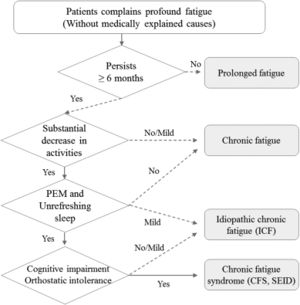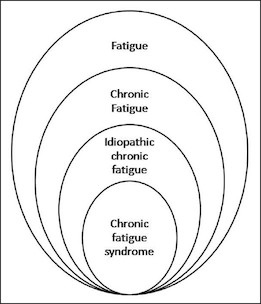Idiopathic chronic fatigue
From MEpedia, a crowd-sourced encyclopedia of ME and CFS science and history
Idopathic chronic fatigue or ICF is long lasting chronic fatigue that is not caused by an underlying medical condition or psychiatric illness.[2] Patients with idopathic chronic fatigue do not fulfill the criteria for chronic fatigue syndrome (CFS).[3] The word idiopathic reflects an unknown underlying cause, meaning that the chronic fatigue is a medically unexplained symptom.[2][4]
Differences from chronic fatigue syndrome[edit | edit source]

Chronic Fatigue Syndrome (CFS) is a distinct neurological disease, and is not the same as chronic fatigue, or long-term fatigue with no known cause (ICF).[3] Source: Son, C-G (2019). Differential diagnosis between “chronic fatigue” and “chronic fatigue syndrome”. Integrative Medicine Research, 8(2), 89-91. Suggested algorithm for chronic fatigue, ICF and CFS. License: CC-BY-ND-NC.
- Idiopathic chronic fatigue is not a distinct illness or disease
- Idiopathic chronic fatigue only requires the symptom of chronic fatigue[3]
- Idiopathic chronic fatigue is more common in the elderly and becomes more common with ageing[2]
- Chronic fatigue syndrome is a neurological disease
- Chronic fatigue syndrome has a multi-systemic illness with a wide variety of symptoms, which may include immune symptoms, cardiovascular symptoms, post-exertional malaise, headaches or migraines, and chronic pain.[3][5]
- Chronic fatigue syndrome is most common in teenagers and working age adults
- Idiopathic chronic fatigue is generally considered less disabling[2]
Notable studies[edit | edit source]
- 2016, Metabolic Rate and Perceived Exertion of Walking in Older Adults With Idiopathic Chronic Fatigue[2] (Full text)
- 2019, Differential diagnosis between “chronic fatigue” and “chronic fatigue syndrome”[3] (Full source)
See also[edit | edit source]
Learn more[edit | edit source]
References[edit | edit source]
- ↑ 1.0 1.1 Singh, Shubh Mohan; Sarkar, Siddharth; Rao, Pradyumna; Balachander, Srinivas (July 1, 2014). "Chronic fatigue syndrome: A review". Medical Journal of Dr. D.Y. Patil University. 7 (4): 415. doi:10.4103/0975-2870.135252. ISSN 0975-2870.
- ↑ 2.0 2.1 2.2 2.3 2.4 Manini, Todd M.; Knaggs, Jeffrey D.; Corbett, Duane B.; Valiani, Vincenzo (November 1, 2016). "Metabolic Rate and Perceived Exertion of Walking in Older Adults With Idiopathic Chronic Fatigue". The Journals of Gerontology: Series A. 71 (11): 1444–1450. doi:10.1093/gerona/glw108. ISSN 1079-5006.
- ↑ 3.0 3.1 3.2 3.3 3.4 Son, Chang-Gue (June 2019). "Differential diagnosis between "chronic fatigue" and "chronic fatigue syndrome"". Integrative medicine research. 8 (2): 89–91. doi:10.1016/j.imr.2019.04.005. ISSN 2213-4220. PMID 31193269.
- ↑ 4.0 4.1 Sigurdsson MD, Alex F. (November 8, 2017). "19 Important Causes of Fatigue - Tiredness and Chronic Fatigue Explained". www.docsopinion.com. Retrieved January 30, 2019. Cite has empty unknown parameter:
|dead-url=(help) - ↑ Fukuda, K.; Straus, S. E.; Hickie, I.; Sharpe, M. C.; Dobbins, J. G.; Komaroff, A. (December 15, 1994). "The chronic fatigue syndrome: a comprehensive approach to its definition and study. International Chronic Fatigue Syndrome Study Group" (PDF). Annals of Internal Medicine. American College of Physicians. 121 (12): 953–959. ISSN 0003-4819. PMID 7978722.


